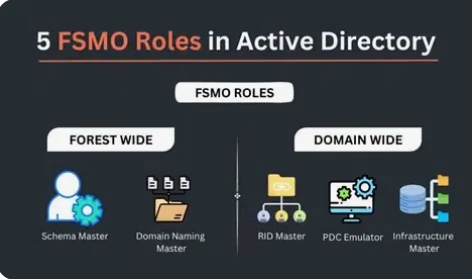Introduction
With the release of Windows Server 2025, Microsoft continues to improve the Active Directory Domain Services (AD DS) platform—enhancing stability, scalability, and security. One crucial component for Active Directory administrators to understand is the management of FSMO (Flexible Single Master Operations) roles.
FSMO roles play a vital part in maintaining a conflict-free and consistent Active Directory (AD) environment. This guide explains what FSMO roles are, how they function in Windows Server 2025, and how to transfer them safely using PowerShell and graphical tools.
What Are FSMO Roles?
There are five FSMO roles in Active Directory, which are categorized by scope. Let’s explore them in detail.. Which are basically divided into two scopes:
Active Directory uses a multi-master replication model. However, some operations must be handled by a single domain controller to avoid conflicts. These operations are assigned to FSMO role holders, of which there are five, categorized by scope:
Forest-wide FSMO Roles
- Schema Master
Controls all updates and modifications to the Active Directory schema. Only one exists per forest. - Domain Naming Master
Responsible for adding or removing domains in the forest.
Domain-wide FSMO Roles
- RID Master
Allocates blocks of Relative Identifiers (RIDs) to domain controllers for object creation. - PDC Emulator
Acts as the primary time source, manages password changes, and provides backward compatibility with legacy systems. - Infrastructure Master
Maintains cross-domain object references to ensure data accuracy.
Why Role Transfer Is Important
FSMO roles are typically transferred when:
- Performing planned maintenance on a role-holding DC
- Demoting or decommissioning a domain controller
- Balancing load across domain controllers
- Improving fault tolerance and availability
FSMO role transfers should be done gracefully when possible. In failure scenarios, roles can be seized, but this is a last resort.
How to Check FSMO Role Holders
To identify which domain controller holds each role:
Get-ADForest | Format-List SchemaMaster,DomainNamingMaster
Get-ADDomain | Format-List PDCEmulator,RIDMaster,InfrastructureMaster
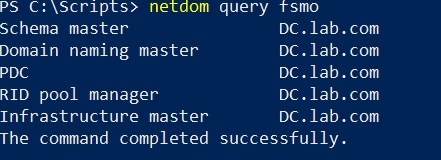
Transferring FSMO Roles in Windows Server 2025
PowerShell remains the most efficient and scriptable way to manage FSMO roles. In Windows Server 2025, the following cmdlet is used:
Move-ADDirectoryServerOperationMasterRole -Identity “DC01” -OperationMasterRole PDCEmulator,RIDMaster,InfrastructureMaster
- Replace DC01 with the name of the target domain controller.
- List the roles you want to transfer.
Manual Transfer Using GUI Tools
- Active Directory Users and Computers (ADUC)
- Right-click the domain → Operations Masters

Before transferring the roles using GUI tools, ensure you’re connected to the target domain controller, or you’ll encounter an error.
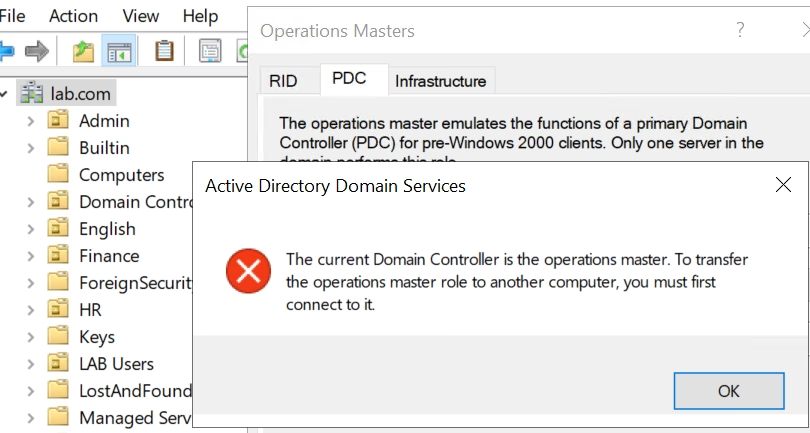
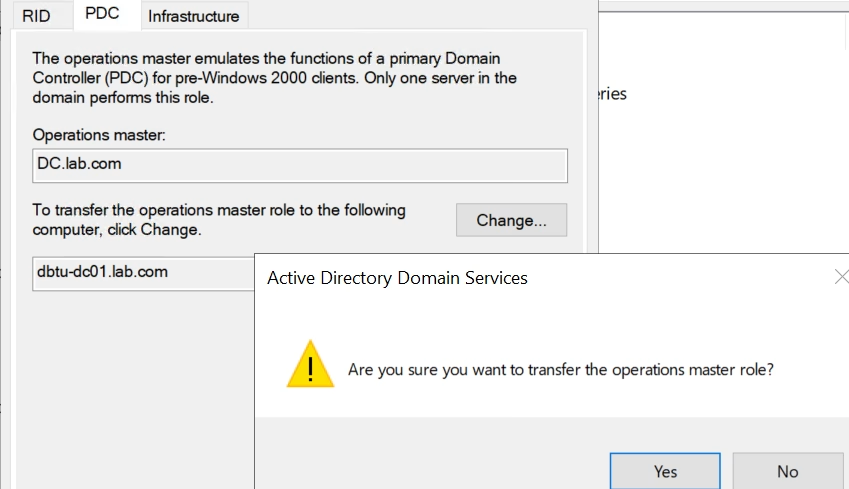
- Active Directory Domains and Trusts
- we have to follow above steps for all the roles to transfer
- Right-click root node → Operations Master
- Active Directory Schema Console
- Register schema snap-in → regsvr32 schmmgmt.dll
- Load MMC → Add Active Directory Schema snap-in
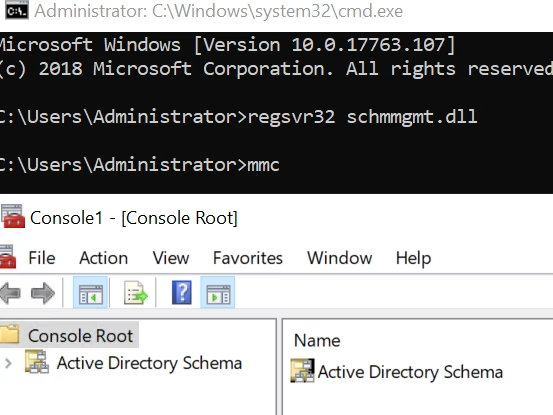
FSMO Role Seizure
If the current role holder is permanently offline, use this command:
Move-ADDirectoryServerOperationMasterRole -Force
Seizing is a last resort. Never bring the original FSMO holder online again without reformatting or cleaning metadata, or it could cause replication corruption.
Best Practices for FSMO Management
- Keep the PDC Emulator on a well-connected and secure domain controller.
- Don’t place the Infrastructure Master on a Global Catalog server unless all DCs are GCs.
- Regularly monitor replication health and backup FSMO role holders.
- Document the location of FSMO roles as part of your disaster recovery plan.
7. Troubleshooting Role Transfers
- Common issues (replication lag, DNS misconfiguration)
- Checking role holders:
Get-ADForest | Format-List SchemaMaster,DomainNamingMaster
Get-ADDomain | Format-List PDCEmulator,RIDMaster,InfrastructureMaster
What’s New in Windows Server 2025?
As of Windows Server 2025, Microsoft has:
- Enhanced PowerShell modules for AD role management
- Improved performance for inter-site replication
- Strengthened role transfer auditing via Event Viewer and Azure AD Connect (if hybrid)
While core FSMO concepts remain unchanged, improved logging, diagnostics, and resilience make role transfers safer and more transparent than in previous versions.
Conclusion
FSMO roles are a foundational element of any Active Directory domain. Whether you’re planning maintenance, decommissioning a server, or responding to an emergency, knowing how to transfer and troubleshoot FSMO roles is essential for a secure and healthy AD environment.
Windows Server 2025 introduces useful updates while keeping the FSMO model familiar. By combining best practices, PowerShell automation, and proper planning, IT professionals can manage FSMO roles with confidence and precision.
